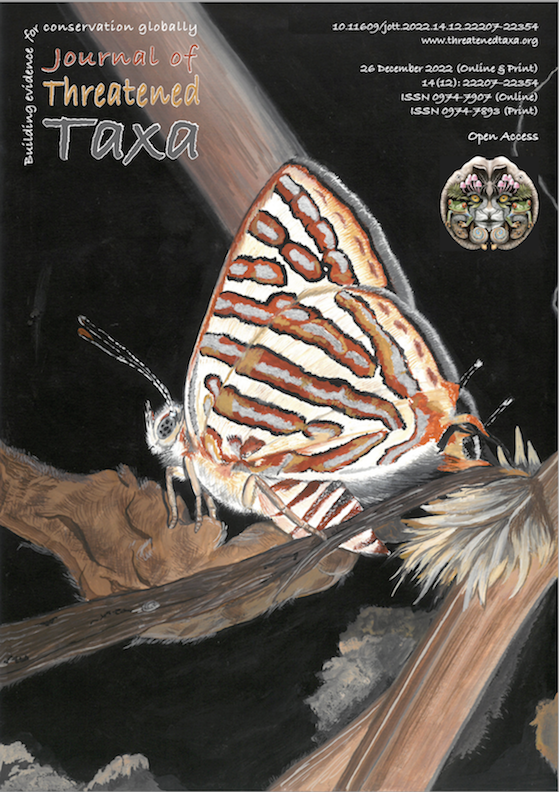New distribution record and DNA barcoding of Sapria himalayana Griff. (Rafflesiaceae), a rare and endangered holoparasitic plant from Mizoram, India
Main Article Content
Abstract
Sapria himalayana Griff. is a rare and endangered holoparasitic plant that prefers a specific host (Tetrastigma sp.). It is one of the lesser-known and poorly understood plants facing threats of extinction owing to human interference in the evergreen forests of Mizoram. The flower is the only visible part of this endophyte and blooms from November to December. The plant was encountered for the first time in the evergreen forest near Rullam village in the Serchhip District of Mizoram, India. In the present study, DNA barcoding was used to identify the plants, and the internal transcribed spacer 2 (ITS2) region of S. himalayana was amplified and sequenced. The ITS2 sequence could accurately identify up to the species level for this endangered species. The absence of the ribulose-biphosphate carboxylase gene (rbcL) region in the genome supports its holoparasitic nature. Hence, DNA barcoding can help in taxonomic and biodiversity research and aid in selecting taxa for various molecular ecology and population genetics studies. The phylogenetic tree was analyzed using the maximum-likelihood method, and our findings showed that species from different families were clearly discriminated in a phylogenetic tree. To the best of our knowledge, this is the first report of DNA barcoding using ITS2 region of S. himalayana from Mizoram, India.
Article Details

This work is licensed under a Creative Commons Attribution 4.0 International License.
Authors own the copyright to the articles published in JoTT. This is indicated explicitly in each publication. The authors grant permission to the publisher Wildlife Information Liaison Development (WILD) Society to publish the article in the Journal of Threatened Taxa. The authors recognize WILD as the original publisher, and to sell hard copies of the Journal and article to any buyer. JoTT is registered under the Creative Commons Attribution 4.0 International License (CC BY), which allows authors to retain copyright ownership. Under this license the authors allow anyone to download, cite, use the data, modify, reprint, copy and distribute provided the authors and source of publication are credited through appropriate citations (e.g., Son et al. (2016). Bats (Mammalia: Chiroptera) of the southeastern Truong Son Mountains, Quang Ngai Province, Vietnam. Journal of Threatened Taxa 8(7): 8953–8969. https://doi.org/10.11609/jott.2785.8.7.8953-8969). Users of the data do not require specific permission from the authors or the publisher.
References
Ahmad, A., A. Kumar, S.G. Rawat & G.V. Gopi (2020). Recent record of a threatened holoparasitic plant Sapria himalayana Griff. in Mehao wildlife Sanctuary, Arunachal Pradesh, India. Journal of Threatened Taxa 12(10): 16399–16401. https://doi.org/10.11609/jot.5168.12.10.16399-16401
Borah, D. & D. Ghosh (2018). Sapria himalayana. Resonance 23(4): 479–489.
Cai, L., B.J. Arnold, Z. Xi, D.E. Khost, N. Patel, C.B. Hartmann, S. Manickam, S. Sasirat, L.A. Nikolov, S. Mathews, T.B. Sackton & C.C. Davis (2021). Deeply altered genome architecture in the endoparasitic flowering plant Sapria himalayana Griff. (Rafflesiaceae). Current Biology 31: 1002–1011.
Cosaic, E, P.M. Hollingsworth, S. Lavergne & P. Taberlet (2016). From barcodes to genomes: Extending the concept of DNA barcoding. Molecular Ecology 25: 1423–1428.
Doyle, J.J. & J.J. Doyle (1990). Isolation of plant DNA drom fresh tissue. Focus 12: 13-15.
Elliott, S. (1990). The distribution, status and ecology of Sapria himalayana Griff. (Rafflesiaceae) in Thailand. The Bulletin of British Ecological Society 11: 246–248.
Feng, S., K. Jiao, Y. Zhu, H. Wang, M. Jiang & H. Wang (2017). Molecular identification of Physalis species (Solanaceae) using a candidate DNA barcode: the chloroplast psbA-trn H intergenic region. Genome 61: 15–2.
Hajra, P.K. (1996). A Contribution to the Flora of Namdapha, Arunachal Pradesh. Botanical Survey of India, Kolkata, India, 476 pp.
Kang, Y., Z. Deng, R. Zang & W. Long (2017). DNA barcoding analysis analysis and phylogenetic relationship of tree species in tropical cloud forests. Scientific Report 7(1): 1–9. https://doi.org/10.1038/ s41598-017-13057-0.
Kumar, S., G. Stecher, M. Li, C. Knyaz & K. Tamura (2018). MEGA X: molecular evolutionary genetics analysis across computing platforms. Molecular Biology and Evolution 35(6): 1547–1549.
Lakshminarasimhan, P., W. Arisdason, S. Bandyopadhyay, T.K. Paul, E.N.V.I.S. Team, S. Gantait, T. Chakrabortty, S. Nandi, D.E. Operator, M.K. Das & N.P. Balakrishnan (2013). “Sapria himalayana (Rafflesiaceae) from Mizoram”. Envis Newsletter 18(1): 2.
Osathanunkul, M. (2019). eDNA-based monitoring of parasitic plant (Sapria himalayana). Scientific Reports 9(1): 1–5. https://doi.org/10/1038/s41598-019-45647-5
Posada, D., & K.A. Crandall (2001). Selecting the best-fit model of nucleotide substitution. Systematic Biology 50(4): 580–601.
Rubiales, J.M., L. Hernández, F. Romero & C. Sanz (2011). The use of forest resources in central Iberia during the Late Iron Age. Insights from the wood charcoal analysis of Pintia, a Vaccaean oppidum. Journal of Archaeological Science 38(1): 1–10. https://doi.org/10.1002/9780470015902.a0021271
Saddhe, A.A. & K. Kumar (2018). DNA barcoding of plants: selection of core markers for taxonomic groups. Plant Science Today 5(1): 9–13.
Trần, H.Đ., H.T. Lưu, Q.Đ. Nguyễn, H.C. Nguyễn, P. Athen & K.M. Wong (2018). Identification, sexual dimorphism and aspects of the natural history of Sapria himalayana (Rafflesiaceae) on Vietnam’s Lang Biang Plateau. Botanical studies 59(1): 1–10.
Yang, F., F. Ding, H. Chen, M. He, S. Zhu, X. Ma, J. Li & H. Li (2018). DNA barcoding for the identification and authentication of animal species in traditional medicine. Evidence-Based Complementary and Alternative Medicine. https://doi.org/10.1155/2018/5160254
Zahra, N.B., Z.K. Shinwari & M. Qaiser (2016). DNA barcoding: a tool for standardization of herbal medicinal products (HMPS) of Lamiaceae from Pakistan. Pakistan Journal of Botany 48: 2167–2174.

